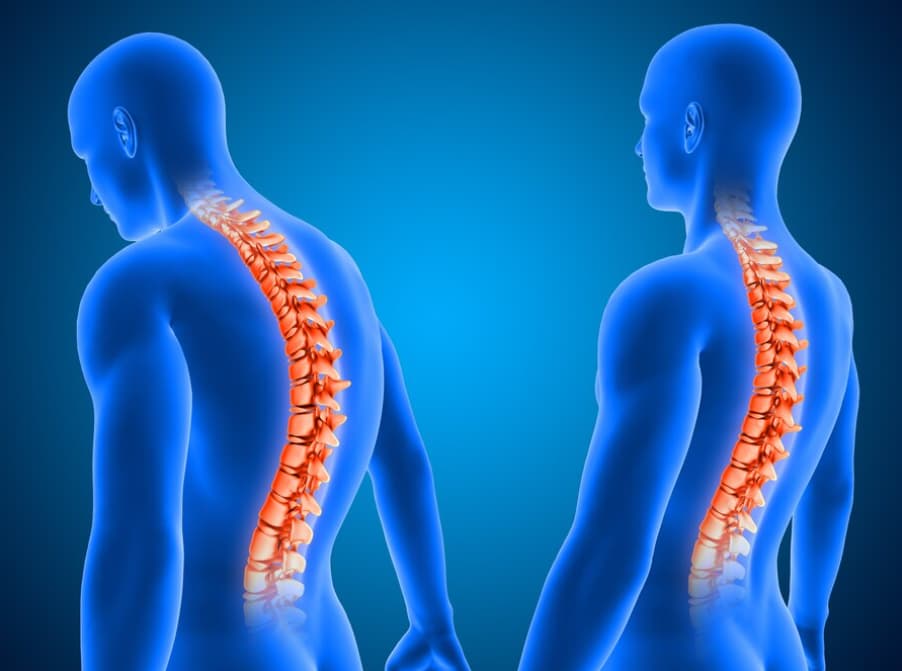Chiropractic care offers a solution to improving your posture by pinpointing and addressing the root issues causing poor alignment. By resolving these underlying problems, you can naturally achieve a straighter sitting and standing position without the need for constant self-reminders. Discover the benefits of enhanced posture and how a chiropractor can guide you toward attaining it.
Can Chiropractors Help Improve Your Posture?
Achieving and maintaining a neutral spine, or good posture, is crucial for avoiding back pain, injuries, and various other health issues. Good posture not only boosts your health, mood, and self-confidence but also influences how others view you. It plays a significant role in presenting a professional image, keeping your organs functioning properly, and slowing down the physical signs of aging.
Whether you’re dealing with back and shoulder pain or simply aiming to enhance your posture for an overall better quality of life, a chiropractor can provide the necessary support. Chiropractors are skilled in identifying postural imbalances, such as uneven shoulders, which can significantly affect the spine and body over time.
Addressing issues like slouching or forward head posture is crucial since these can place extra strain on the spine. Chiropractic care can effectively address conditions like hunchback, uneven hips, pelvic imbalances, scoliosis, kyphosis, and alterations in the spine’s natural curve, leading to an improvement in posture.
The Significance of Maintaining a Good Posture
Maintaining good posture is crucial for various aspects of our health and well-being. Whether standing, walking, sitting, or lying down, adopting proper posture minimizes strain and tension on muscles and ligaments, enabling us to perform daily tasks more effectively. By reducing stress on the back and neck, good posture also helps prevent potential future problems in these areas, ultimately enhancing overall physical health and comfort.
While the immediate benefits of good posture are apparent, it’s important to recognize the deeper, long-term advantages it offers. Optimal posture diminishes the strain on ligaments, thereby lowering the risk of injury. Moreover, it aids in preventing muscle strain, overuse, and discomfort, particularly when coupled with regular exercise routines.
Efficient muscle usage associated with good posture results in energy conservation during daily activities. Furthermore, maintaining proper alignment reduces the chances of abnormal wear and tear on joints over time. Beyond physical health, correct posture can have positive effects on mental well-being and digestion, while also bolstering self-confidence.
In essence, prioritizing good posture isn’t just about appearance; it’s a fundamental aspect of maintaining overall health and vitality.
Factors Contributing to Poor Posture
- Poor posture can stem from a myriad of factors that disrupt our body’s natural alignment. Daily exposure to gravity’s pull, alongside the unavoidable impacts of injuries, illnesses, or genetic predispositions, significantly contributes to postural deviations. These elements often converge, making it common for individuals to experience posture issues due to a combination of causes;
- Injuries and the resulting muscle spasms frequently initiate posture problems, followed by issues like muscle tension, weakness, and everyday habits. Mental health concerns, along with the use of certain accessories like shoes, purses, and wallets, further exacerbate postural misalignments. Hereditary factors also play a role, as do specific incidents such as whiplash from auto accidents;
- Particular lifestyle choices and habits add to the risk. For example, men carrying wallets in their back pockets can misalign their hips and spine, potentially causing significant discomfort. Women, on the other hand, may face shoulder imbalances from carrying heavy bags on one side, with the added strain from wearing high heels intensifying these issues;
- The digital era introduces its own set of challenges, with extended periods spent in front of computers or smartphones leading to neck and shoulder strain. Incorrect sleeping positions or unsupportive mattresses further contribute to poor posture. Additionally, carrying excess weight increases pressure on the skeletal system, promoting postural imbalances.
Choosing the Right Time for Chiropractic Care for Poor Posture

The optimal timing for consulting a chiropractor is sooner rather than later, ideally before issues escalate. Proactively seeking their guidance can aid in averting future problems related to posture. By adhering to their recommendations, chiropractors can assist in preventing improper spinal movements, fostering a life with diminished or no discomfort.
Nevertheless, if you notice signs of poor posture, seeking chiropractic care promptly is advisable. Additionally, individuals who have sustained recent car accidents, sports injuries, or other traumas should prioritize chiropractic visits to expedite recovery and mitigate potential spinal damage.
Furthermore, it’s crucial to schedule an appointment with a chiropractor if you encounter headaches, muscle or joint discomfort, maintain prolonged sitting habits, endure back pain, or observe uneven wear on shoe soles. Symptoms like shooting leg pains and restricted range of motion also signal the necessity of chiropractic intervention. Delaying chiropractic care can lead to present discomfort and future complications.
Various Postural Disorders and Their Effects
Numerous postural disorders can result in discomfort and pain, with the most prevalent types being:
- Kyphosis, characterized by an exaggerated curve of the upper back (thoracic spine), leads to forward-rounded shoulders. Commonly referred to as a hunchback or slouch, this condition often arises as spinal bones wear down with age. Osteoporosis, a condition frequently seen in older women, can prompt this rounding of the shoulders. The degeneration of spinal discs or vertebrae are additional factor linked to aging. However, kyphosis can also affect younger individuals due to hereditary factors, genetics, polio, Scheuermann’s disease, infections, or the aftermath of chemotherapy or radiation treatments for cancer;
- Flatback syndrome is identified by a reduction in the natural curvature of the lower spine, causing individuals to lean forward due to a straightened lower back. This condition may be genetic or result from back surgery or degenerative spine diseases such as inflammatory arthritis (ankylosing spondylitis), disc degeneration, and vertebral compression. Sustaining a flatback posture for extended periods can lead to discomfort;
- Swayback is observed when the hips and pelvis are positioned forward of the body’s midline, causing an inward curvature of the lower back. This posture gives the appearance of leaning backward while standing, with both the stomach and buttocks protruding. Excessive sitting can lead to swayback by causing the back muscles to tighten, thereby weakening the abdominal and gluteal muscles, as well as the core muscles that stabilize the body. Factors such as obesity, injuries, neuromuscular disorders, and spinal or vertebral abnormalities can also contribute to the development of swayback;
- Forward head posture is noted when the ears align in front of the body’s vertical midline instead of being aligned with the vertical midline and shoulders. Often termed tech neck or text neck, this posture results from prolonged periods hunched over phones, computers, or steering wheels, especially common in individuals who drive frequently. Aging and the weakening of upper body muscles are also contributing factors to this postural issue.
The Timeframe for Chiropractic Correction of Poor Posture
Realigning poor posture through chiropractic care typically involves a span of 2-3 weeks for adults. During this period, individuals undergo manual spinal manipulation sessions twice a week, aimed at addressing any existing issues. Following an initial week of intensive alignment work, the frequency of therapy sessions is tapered down to once a week for an additional 2-3 weeks. Substantial improvements in back alignment are typically noticeable after completing this initial phase of treatment.
Following this initial correction phase, the aligned state of the back usually persists for about a month before a reassessment by the chiropractor. After three months of stabilization, a follow-up evaluation is conducted to determine the need for further therapy. It’s common for symptoms to subside during this healing and stabilization period.
However, the duration of this process can vary significantly from person to person. Factors such as individual response to manipulation and stress levels play a role in determining the necessary duration of chiropractic care. Therefore, personalized treatment plans tailored to each individual’s needs are essential for effective results.
Effective Home Remedies for Improving Posture

Improving your posture at home is simpler than you might imagine. Engaging in exercises like pilates and yoga, which emphasize posture movements and overall health, can be incredibly beneficial. Additionally, using a posture belt or corrector can assist in maintaining proper alignment. However, the most crucial aspect is remaining mindful of your posture and promptly addressing any issues that arise.
Other helpful methods include maintaining a healthy weight, opting for low-heeled shoes, and staying physically active. For those with sedentary jobs, arranging your desk to facilitate proper sitting posture and minimize spinal curvature, such as slouching, is crucial. Regular breaks and stress reduction techniques are also essential for preventing tense shoulders.
Moreover, be conscious of your posture while using electronic devices, as prolonged neck stretching and tilting can strain muscles and contribute to neck discomfort. Finally, ensuring good sleep quality on a supportive mattress and pillow is vital for improving posture while at home.
Conclusion
Your posture isn’t just about how you carry yourself while walking; it extends to various aspects of your physical, mental, and emotional health. Correcting poor posture requires dedication and time. Simply reminding yourself to stand straight won’t be effective if underlying issues contribute to your poor posture. A chiropractor can help address poor posture, whether it stems from an injury, stress, or other factors. If you’re experiencing back pain or any symptoms of poor posture, seeking treatment from a licensed chiropractor promptly is advisable.



